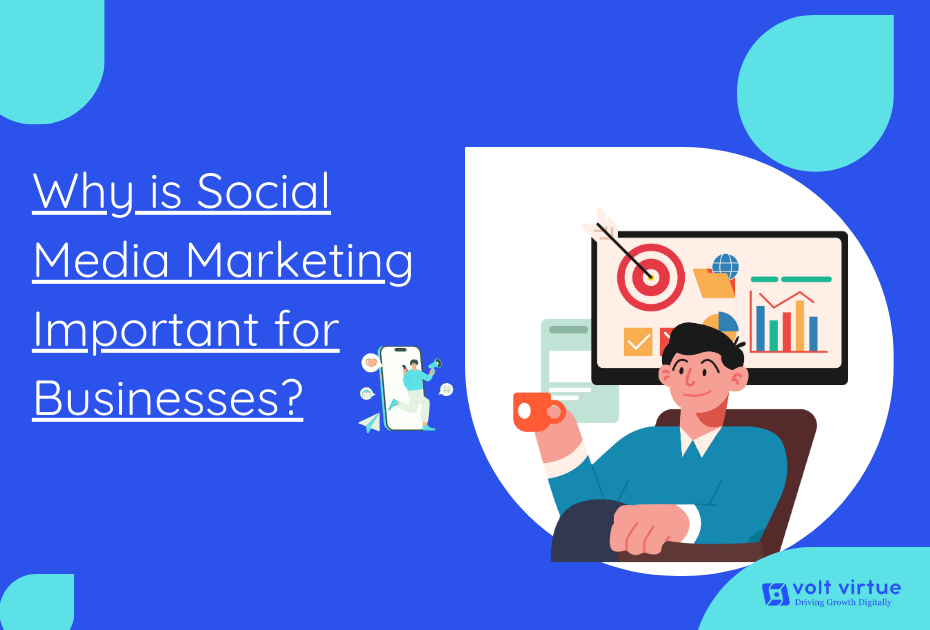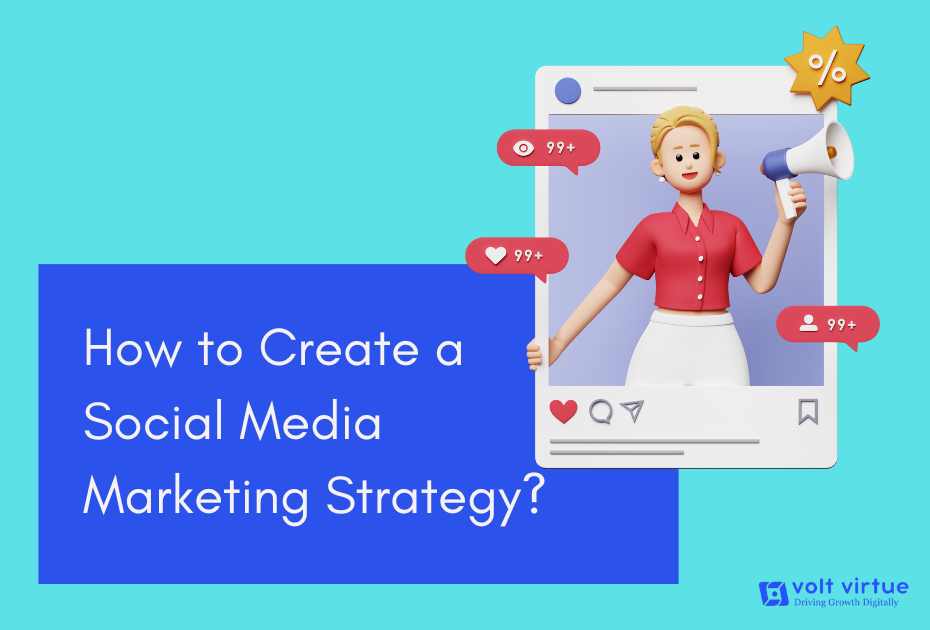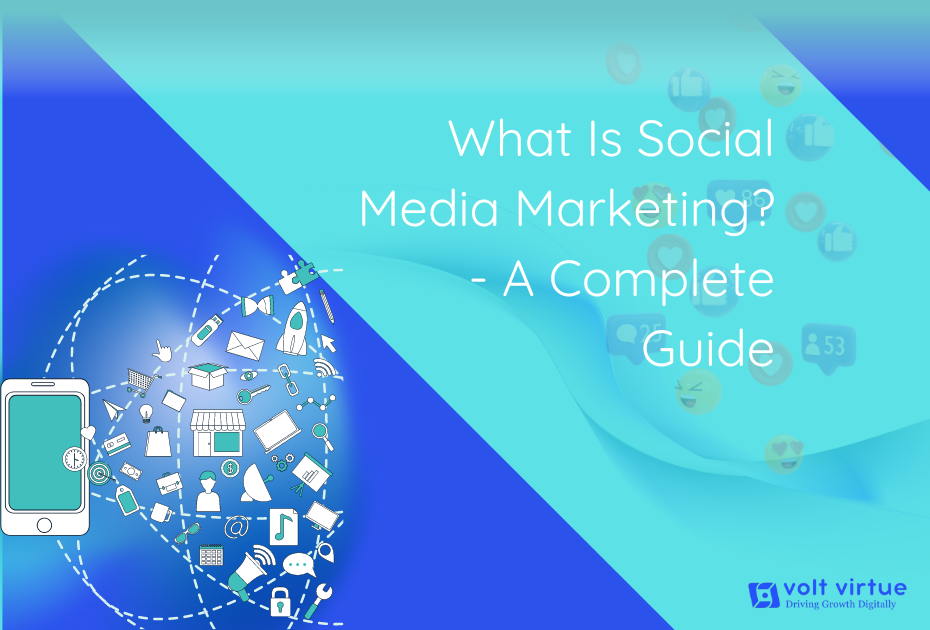
Social media is one of the most powerful tools in digital marketing — it allows you to connect with your target audience where they spend most of their time and build lasting, meaningful relationships.
Every day, users spend hours on their favorite social platforms, and importantly, many of them use these platforms to discover new products and brands. While social media is often seen as a way to stay connected with friends and family, a significant portion of users actively seek out new products on platforms like Facebook, Instagram, YouTube, and others. This makes it crucial for businesses to engage with potential customers on their preferred social channels.
Social media marketing is now a vital component of the digital marketing strategy for businesses of all sizes. With 4.9 billion people using social media platforms globally, having a presence on these platforms is a powerful way to engage both current and potential customers. Regardless of your industry, social media provides an effective way to reach your target audience, strengthen your brand, build customer loyalty, and ultimately, boost revenue.
In this guide, we’ll cover everything you need to know about social media marketing, including what it is, how it works, the best strategies, and how to implement them successfully.
What is Social Media Marketing?
Social media marketing (SMM) leverages social media platforms to engage with your audience, build your brand, boost sales, and drive traffic to your website. It encompasses publishing high-quality content on your profiles, engaging with followers, analyzing performance, and running targeted social media ads.
With numerous social platforms available, selecting the best channels for your marketing efforts is key to success. Additionally, a variety of social media management tools can help your business maximize its social media presence and streamline your marketing strategy.
After setting up your business profiles, it’s important to maintain and optimize them regularly. Your posts should incorporate a mix of text, images, videos, and stories that positively highlight your brand while actively engaging your target audience.
In addition to posting consistently, you’ll need to interact with comments, likes, and shares to manage your reputation and foster a sense of community. Depending on your budget and goals, social media marketing can also involve paid ads that strategically place your brand in front of the right audience at the right time.
Why is Marketing Through Social Media So Effective?
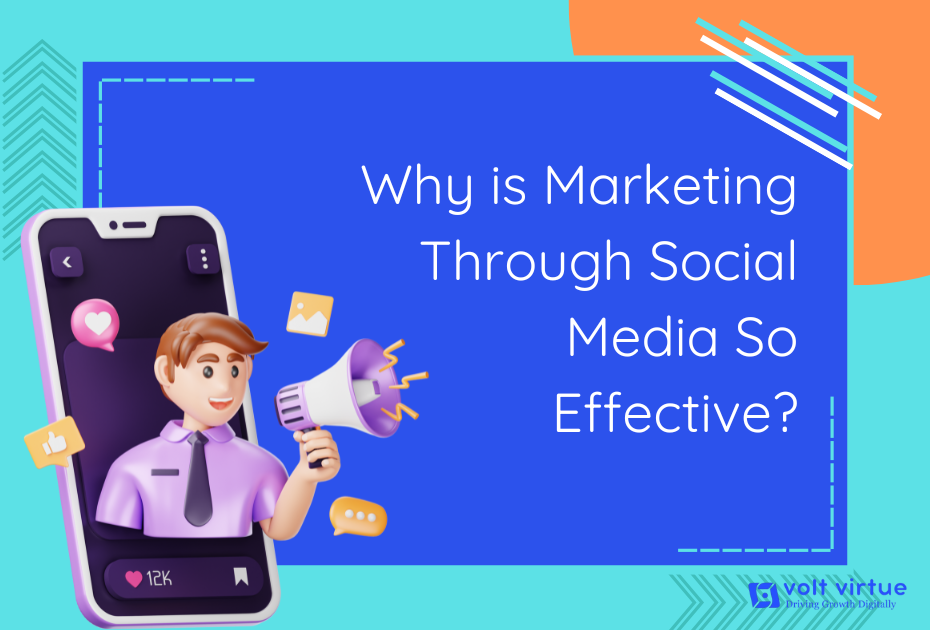
Marketing through social media is highly effective because it taps into a vast audience—more than half of the global population actively engages with these platforms. Additionally, 76% of social media users have made a purchase based on what they saw on social media.
Here’s a quick breakdown by platform:
- Snapchat: Snapchat users hold a global spending power of $4.4 trillion.
- YouTube: 68% of users watch videos to help them make purchase decisions.
- Instagram: 50% of users visit a brand’s website after watching their Stories.
- TikTok: Brands experience 1.7 times more product discovery compared to other platforms.
- Pinterest: 50% of users view the platform as a shopping destination.
Before the advent of social media, brands relied on traditional advertising methods such as TV ads, billboards, radio spots, flyers, and magazine placements. These approaches aimed to reach customers through scheduled content delivery.
With social media, brands can directly engage with their audience in real time. People now spend approximately 2 hours to 3 hours daily on social media, which constitutes more than 30% of their total online activity. This shift allows brands to connect with potential customers more effectively and immediately.
Social media marketing delivers your message straight to your customers and provides precise metrics on how well each post, comment, and ad performs in achieving your goals.
This level of detailed analytics is not typically available with traditional advertising platforms. Moreover, the vast number of social media users presents a tremendous opportunity for businesses aiming to expand their reach and grow their audience.
Benefits of Social Media Marketing
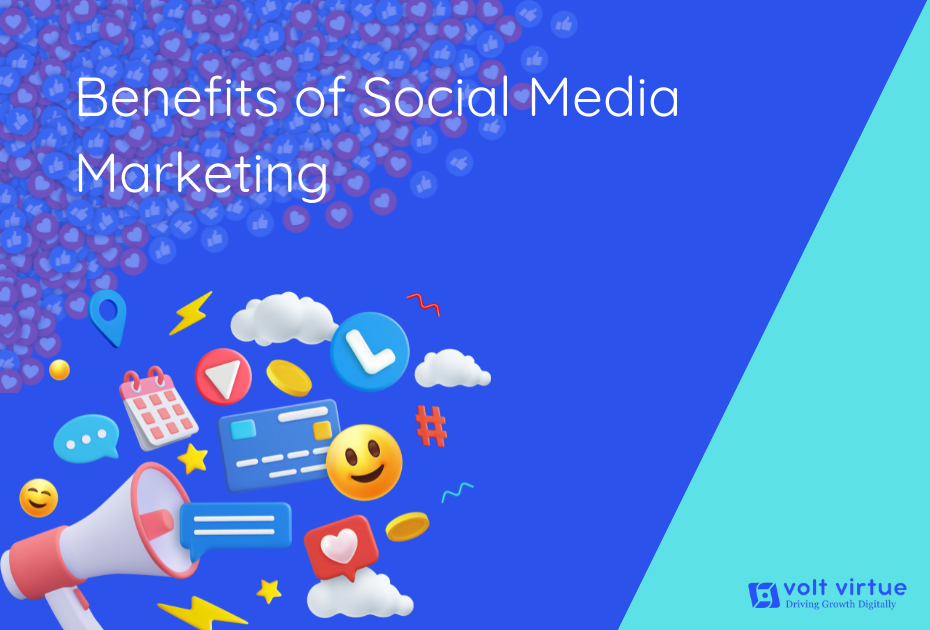
1. Increase your brand awareness
Social media platforms offer a valuable opportunity for brands to shape their image and enhance their visibility. With billions of users worldwide, these platforms provide unmatched exposure, making them essential for reaching a broader audience.
Brand awareness is essential for attracting potential customers to your business. When people interact with you on social media, they gain insight into your brand and what you have to offer. Social media allows you to put your brand directly in front of prospects.
By posting content that appears in your followers’ newsfeeds and encouraging them to share it with their own networks, you can expand your online presence. This increased visibility helps more people discover your business, ultimately boosting brand awareness.
2. Enhanced Customer Engagement
Social media’s interactive nature allows businesses to engage directly with their audience through comments, messages, and posts. This two-way communication strengthens customer relationships and fosters loyalty. By creating dynamic interactions, businesses can build a community around their brand, making customers feel valued and heard.
3. Building Genuine and Faster Relationships with your Customers
A key strength of social media marketing is its ability to foster authentic relationships between brands and consumers. Through platforms like Facebook, X (formerly Twitter), TikTok, and Instagram, businesses can engage in direct conversations with their audience, offering a personalized marketing approach that strengthens brand identity and loyalty.
Connecting and engaging with your social media followers helps build lasting relationships between them and your business. You can achieve this by interacting with them through your posts, responding to their questions and comments, and offering any necessary support.
Additionally, you can ask your followers questions about your products and their pain points or run giveaways to build trust, showing how much you value their input and support.
4. Rich insights on customer behavior
Social media platforms provide valuable marketing data that can help your business better understand its audience. By reviewing your analytics, you can identify which topics resonate with users, determine the best times to post new content, and gain insights to refine your marketing strategy.
5. Access to Global Markets
Social media breaks down geographical barriers, enabling brands to reach global markets. This is especially advantageous for small and medium-sized enterprises (SMEs) looking to expand their reach beyond local audiences.
6. Drive Traffic to Your Website
Your social media profile, posts, and ads offer valuable opportunities to include links to your website. This helps direct more users to your site, encouraging them to explore your products or services.
7. Generate Leads
With features like appointment booking, call-to-action buttons, Facebook and Instagram shops, and direct messaging, social media provides multiple avenues to generate leads and drive conversions. These leads and conversions can directly contribute to increased revenue.
How Does Social Media Marketing Work?
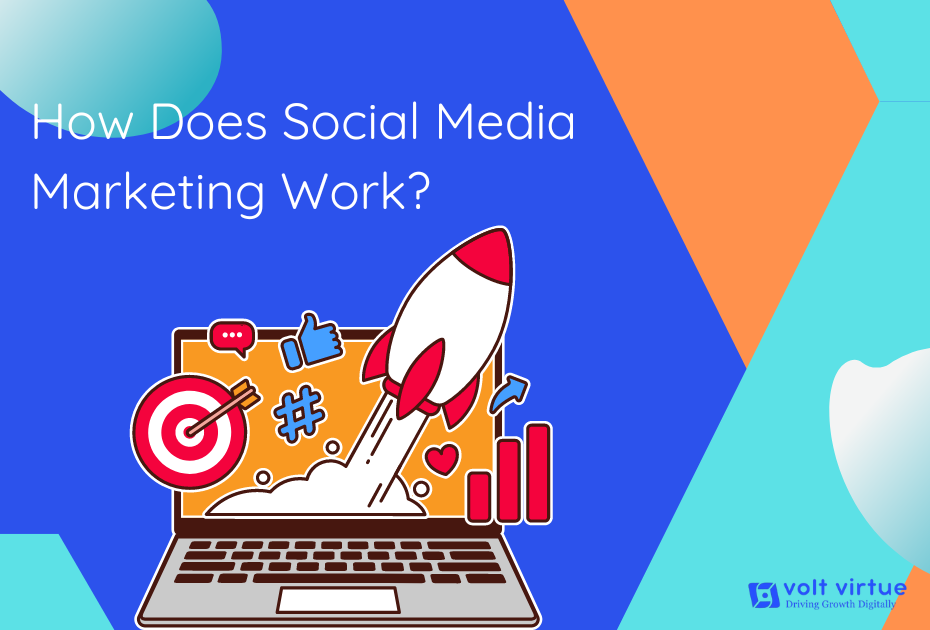
In essence, social media marketing promotes your brand to audiences across various platforms. It provides businesses with an opportunity to showcase their identity, products, and unique selling points, while customers can explore a diverse range of products and services from the convenience of their devices.
There are numerous ways to leverage social media for business promotion, from crafting engaging and humorous video content to developing detailed, data-driven reports that demonstrate industry expertise.
Social media marketing encompasses several key activities:
- Content Planning and Creation: This involves developing content tailored to each platform to effectively connect with the audience. It serves as the foundation for your online persona on social networking.
- Content Scheduling and Publishing: This is about strategically posting your content on various platforms at optimal times to reach and engage your target audience.
- Social Media Analytics: Utilize analytics tools to track content performance, measure progress towards goals, and identify areas for improvement.
- Social Listening: Monitor online conversations about your brand and industry using social media tools. This helps with competitor research and understanding audience sentiment.
- Community Management: Engage with your followers to foster a vibrant online community. Respond to messages, encourage interaction, and create opportunities for engagement.
- Social Media Advertising: Employ paid advertising tools on social networks to expand your reach. This may involve collaborating with influencers or external content creators to enhance visibility.
How to Create a Social Media Marketing Strategy
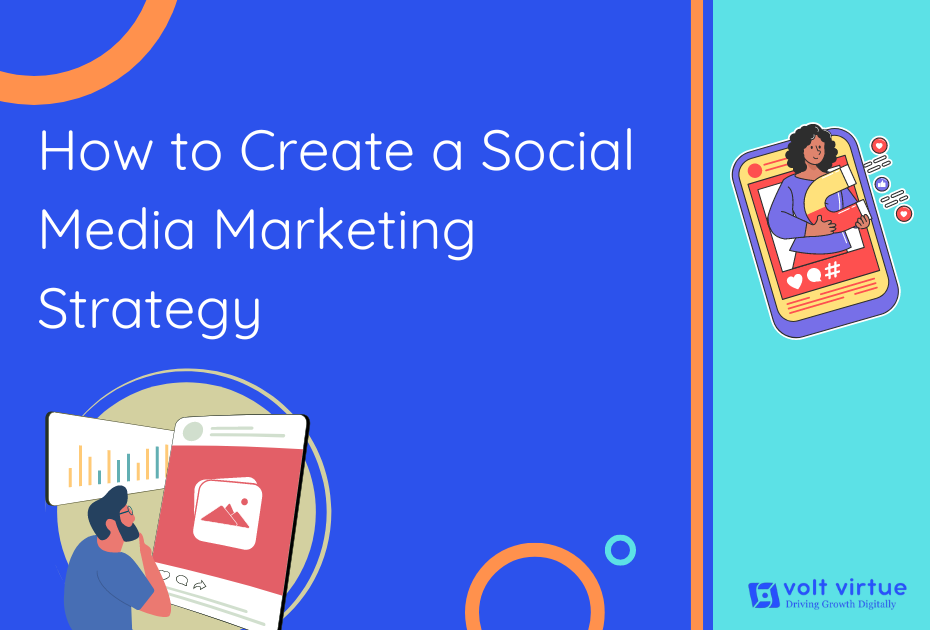
A social media marketing strategy is a detailed plan that defines your goals for social media and the methods you’ll use to achieve them. It serves as a roadmap for your actions and helps measure your success.
In this section, we’ll explore how to build a successful social media strategy:
1. Set Social Media Marketing Goals
The initial step in creating a social media marketing strategy is to set clear social media goals that align with your broader business objectives.
Ask yourself: What do you aim to achieve with your social media efforts? Typical goals include raising brand awareness, driving website traffic, generating leads, increasing customer engagement, and improving customer satisfaction.
Once you’ve established your high-level goals, break them down into smaller, actionable steps. This process helps you pinpoint the specific actions and strategies needed to reach your goals.
For instance, if your goal is to drive more traffic to your website through social media, actionable steps might include increasing your posting frequency, optimizing content for better sharing, or launching targeted ad campaigns.
Build a solid foundation for your social media strategy by setting SMART goals: Specific, Measurable, Achievable, Relevant, and Time-bound.
2. Identify Ideal Customers
Successful marketing hinges on understanding your target audience—their preferences, the platforms they use, and their interests. The more insight you have into your ideal customer, the easier it will be to create content that resonates with them and converts them into customers.
Start by creating an ideal customer profile. This involves making an educated guess about the type of person most likely to convert.
Facebook, with nearly 3 billion active users, is a great platform for audience research. Visit competitors’ pages and look at their most engaged followers to get a sense of who they are. This will help you build a detailed profile of your ideal customer, which could include:
- Gender
- Age
- Relationship status
- Location
- Interests
- Job title
- Income
- Preferred social network
- Buying motivation
- Barriers to purchasing
This profile will enable you to refine your social media marketing strategy and create more targeted content.
3. Select Your Platforms
With hundreds of social media platforms available, it’s important to focus on the ones your ideal customers use.
Consider your audience’s behaviors and where they spend their time online. If they are active on Pinterest, focus your efforts there. If TikTok is where they engage most, prioritize that platform,” Morgan advises. “Direct your efforts towards platforms where your ideal client avatar is most active to maximize effectiveness and avoid wasting time on less impactful channels.”
When creating content, tailor it to the strengths of each platform. For instance, if your content is video-centric, platforms like YouTube, which are optimized for video, are ideal.
However, don’t feel restricted to only the best-fit channels. It’s important to maintain a presence on multiple platforms and to experiment with emerging or less conventional ones. This approach not only diversifies your strategy but also enables you to connect with the distinct audiences and meet the specific needs of each platform.
Once you’ve selected the platforms, develop a separate content strategy for each. Every platform operates differently—some prioritize video content, while others perform better with images or text-based posts. If your focus is Instagram, Facebook, and YouTube, tailor your content approach for each to maximize engagement and results.
4. Determine How to Convey Your Brand
One of the major advantages of social media is its ability to showcase your brand’s personality through your posts. Before you make your first post, define your brand identity and decide how you want to present it to your audience. This involves establishing a consistent tone, style, and messaging that aligns with your brand values and resonates with your target audience.
You need to define your social media identity by determining your brand’s personality and deciding how to effectively convey that personality to your audience.
5. Create a Social Media Content Strategy
Next, focus on developing your social media content plan. Given the importance of content for businesses, we have dedicated an entire chapter to top social media content ideas. Here, we’ll outline a few actionable steps for creating a robust social media content strategy.
Conduct a Social Media Audit: Start by auditing your existing social media channels to review past efforts and assess whether they align with your updated marketing goals and target audience. If any platforms no longer fit your objectives or audience, consider scaling back your efforts on those platforms to concentrate on more relevant ones. For platforms you continue to use, ensure all links are updated and that your company information is consistent with your current brand image and standards. Analyze the performance of your posts to determine what has worked well and plan to replicate those strategies while minimizing less effective approaches.
Check Out the Competition: Monitoring your competitors’ social media channels can provide valuable insights into how your niche performs across different platforms. By examining their content strategies, you can identify what works well and what doesn’t, gaining inspiration for your own approach. Evaluating their strengths and weaknesses can help you refine your strategies and set your brand apart in the marketplace.
Decide on Types of Social Media Content: Based on the channels you’ve selected, determine the types of content you’ll focus on, such as images, videos, Instagram Stories, IGTV, interviews, company news, or user-generated content. Ensure that your content aligns with your company’s voice and resonates with your target audience.
Determine Posting Times: Include guidance in your social media content plan on the optimal times to post your content. For example, if your business is based in Europe but your audience is primarily in the Americas, posting later in the day might be more effective. Try posting at various times to discover when your audience is most active and engaged.
Establish a Posting Frequency: Determining the optimal posting frequency is key to sustaining audience engagement. Avoid posting too frequently, which could annoy your followers, or too infrequently, which might cause them to forget about you. Strive for a balance that maintains audience engagement without overwhelming them.
6. Identify the Metrics You Want to Track
Tracking the success of your social media campaigns is essential for optimizing your strategy and achieving better results. To do this effectively, identify your key performance indicators (KPIs) that align with your campaign goals.
Some standard metrics to consider tracking include:
- Engagement Rate
- Website Traffic
- Brand Awareness
- Post Reach
- Click-Through Rate (CTR)
- Bounce Rate
- Conversions
By monitoring these KPIs, you can assess how well your content is performing and make data-driven adjustments to enhance your social media strategy.
7. Evaluate Your Content Strategy
It’s time to step back and assess the overall effectiveness of your social media marketing strategy. Ask yourself: Is our strategy effectively meeting our business goals?
To answer this, review your social media analytics reports. Instead of focusing on the performance of individual posts, consider whether your social media activities are contributing to your broader business objectives.
It’s crucial to make this distinction. For instance, while you might see success in terms of gaining followers, boosting engagement, or even going viral, these achievements may not translate into increased sign-ups or sales.
If your strategy isn’t delivering the expected results, revisit earlier steps and make necessary adjustments. Remember, this isn’t a failure—social media platforms are continually evolving, and adapting to these changes is part of the process.
Social Media Marketing Platforms
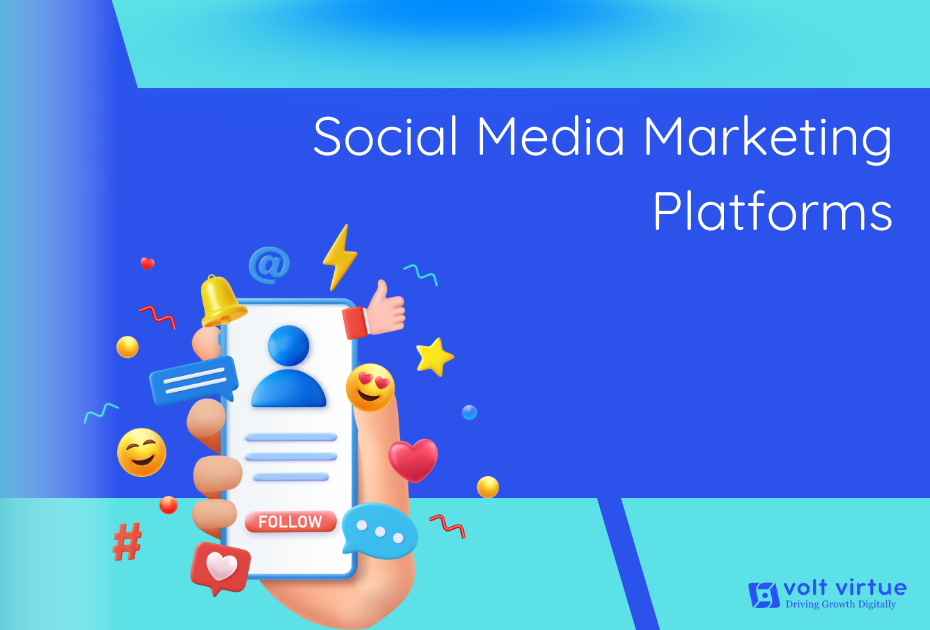
There are numerous social media marketing platforms available, each offering unique opportunities depending on your brand and target audience. As you evaluate your options, you’ll discover that some platforms may align better with your business needs than others. Here’s a brief overview of several key platforms that can enhance your social media marketing strategy:
Facebook is the largest social media platform, making it a powerful tool for reaching your audience, whether through organic growth or paid ads.
As the most popular social media platform, Facebook is a valuable choice for nearly any business. It offers opportunities to boost brand awareness, gain followers, generate leads, and increase sales. Additionally, Facebook provides highly customizable and targeted advertising options. However, keep in mind that its effectiveness is balanced by significant competition.
While growing your presence organically on Facebook is becoming more challenging, it’s still achievable with the right approach.
The key is to consistently post high-quality content, engage actively with your audience, and fully leverage the platform’s features. This includes utilizing Facebook Stories, Facebook Live, and Facebook Groups to maximize your reach and interaction.
Since its launch 13 years ago, Instagram has revolutionized the way brands share visually compelling content. It stands out not only for its focus on stunning visuals but also for its advanced eCommerce tools. With over one billion active monthly users, Instagram is a leading platform for promoting your products or services.
It provides various content formats, including Stories, Reels, Live videos, and more, enabling you to produce diverse and captivating content that engages your audience.
Today, Instagram allows users to discover brands, browse products or services, and complete purchases—all without leaving the app. Instagram’s streamlined buying experience has made it a top social selling platform.
In fact, consumers report that Instagram provides the best in-app shopping experience, making Instagram Shops a top feature among social media marketers.
Instagram started as a simple photo-sharing platform but has since evolved into a powerful tool for engaging audiences with eye-catching visuals. It now offers a range of features, including Stories, Reels, Live streams, and Shops, that can elevate your marketing efforts. If your business depends on striking visuals to highlight your products or services, Instagram is a must-have platform for you.
YouTube
YouTube is the second most visited website worldwide and is also regarded by marketers as the second-best platform for fostering community engagement.
YouTube’s popularity is partly due to its long-form content, which keeps users engaged for longer periods. This makes it an ideal platform for sharing educational and in-depth content. As the second largest search engine after Google, YouTube attracts a diverse audience with its wide range of content, from how-to videos to vlogs.
YouTube offers a prime opportunity for brands to provide an inside look at their company, showcase products, share industry insights, and more. As the second-largest search engine after Google, YouTube is essential for brands that can produce engaging video content. It allows you to explain complex topics, demonstrate processes, highlight unique features, and much more. Your video content campaigns might be substantially enhanced by integrating YouTube into your marketing plan.
For years, YouTube only supported landscape videos, but it has recently introduced portrait short-form videos up to 60 seconds, known as YouTube Shorts.
YouTube also offers shopping tools like YouTube Shopping (available to select users) and YouTube Ads, which allow you to advertise before and during other YouTube videos.
Tik Tok
A relatively new entrant in social media marketing, TikTok has quickly gained traction, amassing over a billion monthly active users in a short span.
TikTok allows users to create and share videos ranging from 15 seconds to 10 minutes, and offers a vast array of filters, AI effects, sounds, and music to make content creation engaging and fun. The platform has also recently added Stories and carousel-style photo posts.
TikTok is a newer social media platform focused on short-form videos and tends to attract a younger, predominantly female audience. TikTok can be a very powerful tool for your business if your target audience is similar to the platform’s user base. By using relevant hashtags related to your posts, brand, and offerings, you can increase the visibility of your content when users search for those hashtags.
When it comes to short-form video, TikTok is often the first platform that comes to mind. Since its meteoric rise in popularity in 2020, TikTok continues to thrive and is now one of the top platforms for community building, ranking third behind YouTube among marketers.
People turn to X (formerly known as Twitter) to stay updated with the latest news, follow brands, and join dynamic conversations.
While Instagram emphasizes visuals, X (formerly Twitter) is all about words. Twitter uses short posts called “tweets,” which can include text, images, animated GIFs, videos, and links. It’s a platform for connecting with your audience through concise, valuable messages. Depending on your business, Twitter can help with customer service, brand awareness, and finding industry-related topics and information. Since its early days with 140-character Tweets (now 280), X has evolved to include features like X Spaces for audio interactions, Twitter Subscriptions for community building, and Twitter Blue for an enhanced experience.
X is an excellent platform for engaging with your audience, offering customer support, and participating in lively discussions.
LinkedIn is a professional network where individuals search for and promote job opportunities, share industry insights, and learn about company culture and work environments.
LinkedIn is a business networking platform that’s ideal for B2B companies. It caters to professionals and offers opportunities to showcase your industry expertise. You can use LinkedIn to promote job openings, connect with employees, and even generate leads through paid ads.
Pinterest excels in visual discovery and inspiration, making it a powerful tool for marketers in industries that rely on strong visual appeal.
Pinterest’s visual search tool enables users to upload an image or use an existing pin to find visually similar items, styles, or products. For shoppers, this technology identifies products within an image and links directly to purchasing options. This seamless integration of search and commerce makes it easy for users to discover and buy products effortlessly.
Pinterest ads and Rich Pins provide businesses with effective ways to engage users who are actively planning purchases. This makes Pinterest a valuable platform for targeted marketing, as it allows you to reach users at key moments in their decision-making process.
Rich Pins offer more detailed information directly on the pin, such as real-time pricing, availability, recipe ingredients, and article headlines. This feature improves the user experience by delivering key information at a glance.
Promoted Pins are regular pins that businesses can pay to boost their visibility and reach a larger audience. They appear in users’ feeds just like regular pins but reach a broader audience. Promoted Pins are an effective way to boost visibility and drive traffic to a website or blog.
Companies can make boards to highlight their goods, distribute content relevant to their brand, or compile themes that align with the interests of their target market. This approach enhances engagement and fosters brand loyalty.
Snapchat
When Snapchat launched in 2011, it pioneered the concept of ephemeral content, allowing users to share messages and media that would disappear after 24 hours.
Snapchat boasts 406 million daily active users. On Snapchat, all images and videos disappear within 10 seconds, the content is inherently fleeting and ephemeral.
This fleeting nature is perfect for sharing behind-the-scenes moments and live updates. For instance, if you’re speaking at a conference, share snaps of your presentation or the event setup. Give your audience a glimpse of office events. Show them the lighter side of your life, whether it’s a funny makeup mishap or a cool ride from the airport.
Snapchat marketing thrives on showcasing those unique, spontaneous moments that capture real life, so make the most of this opportunity.
Social Media Marketing Tips
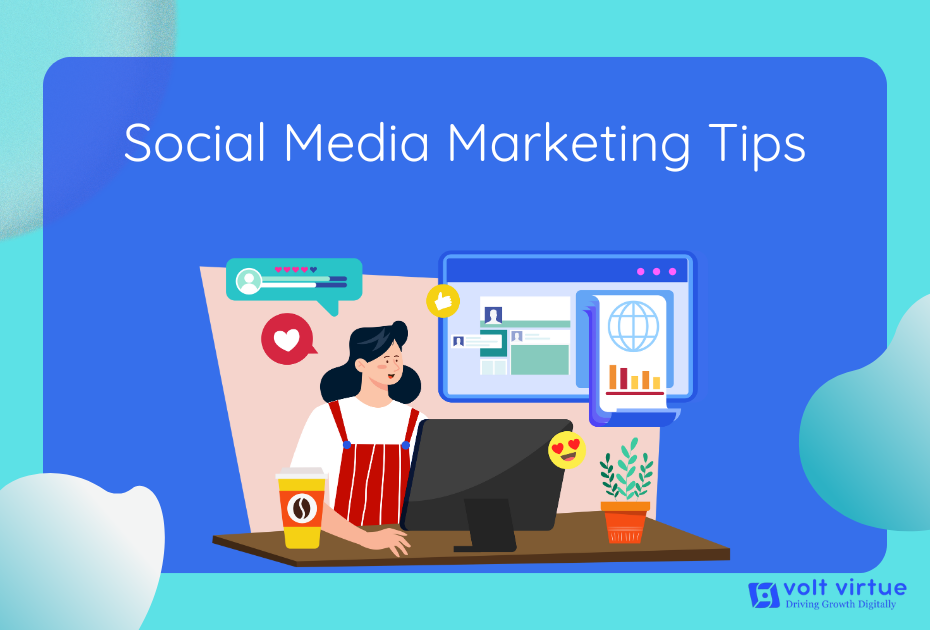
Ready to dive into social media marketing? Here are some essential tips to kick off your social media campaigns effectively:
Create Diverse Content
Content is king in social media marketing, just as it is in other online marketing areas. Ensure you post regularly and provide valuable information that resonates with your ideal customers. This includes:
- Offer practical advice that can help your audience solve problems.
- Share updates that keep your followers informed about the latest trends and relevant events.
- Provide valuable data and insights to establish your authority and assist your audience in making informed decisions.
- Include interactive content in your marketing to get people involved.
- Keep your audience updated on new products, services, and company news.
Make use of various formats, such as images, videos, stories, live streams, and online stores, to keep your content fresh and engaging.
Stay Consistent
Maintaining consistency is key to building a strong brand presence across social media platforms. While each platform has its unique environment and voice, ensure that your brand’s core identity—whether it’s friendly, professional, or fun—remains consistent.
Don’t Just Post—Participate
Social media is a community-driven space, focusing on engagement rather than just posting content. Engage actively with your audience and show that you value your followers’ input by replying to their comments. Foster relationships by engaging with content from your audience. Spark discussions and connect with your audience in real-time. By actively participating in the social media community, you can build stronger relationships and enhance your brand’s presence.
Use Content Creation Tools
Every social media platform thrives on visuals. To stand out in a user’s feed, your posts should be accompanied by eye-catching visuals—photos, illustrations, or text art. Tools like Freepik and Canva offer a range of templates and features that make it easy to create professional-looking visuals. These tools allow you to include your logo and ensure consistency with your brand’s aesthetic.
Repurpose, Repost, Recycle
To effectively navigate the crowded social media landscape and maintain engagement, consider the three Rs:
- Repurpose: Transform existing content into new formats. For example, turn a customer review into a Facebook post, break down a blog post into a series of tweets, or convert a webinar presentation into a LinkedIn carousel. Get creative with how you adapt your content to fit different platforms.
- Repost: Use this strategy sparingly to fill gaps in your content calendar. Repost user-generated content, influencer posts, or curated content from authoritative sources. This not only keeps your feed active but also helps build community and credibility.
- Recycle: Maximize the lifespan of your content by sharing it across multiple platforms. Post your TikTok videos and Instagram Reels to YouTube, reshare high-performing blog posts regularly, and upload your Facebook Live recordings to YouTube. Recycling content ensures that valuable material reaches new audiences and maintains its relevance.
Curate Your Own Feed
While it’s important to focus on appearing in others’ feeds, don’t overlook the value of curating your own. Follow your competitors to stay informed about their strategies, gather ideas to adapt, and identify opportunities to fill gaps in the market. Connect with influencers to keep up with trends and expand your knowledge. Additionally, follow brands that align with your values or excel in content strategies to draw inspiration and spark innovative ideas.
Measure Success with Analytics
To evaluate the effectiveness of your social media marketing strategies, it is essential to track data. Google Analytics is a valuable tool for assessing the success of your social media campaigns and identifying which tactics are most effective. Implement tracking tags to monitor your campaigns accurately. Additionally, leverage the analytics tools provided by each social platform to gain deeper insights into how your content performs with your audience.This approach will help you refine your strategies and focus on what resonates most with your followers.
Building and Engaging Your Community
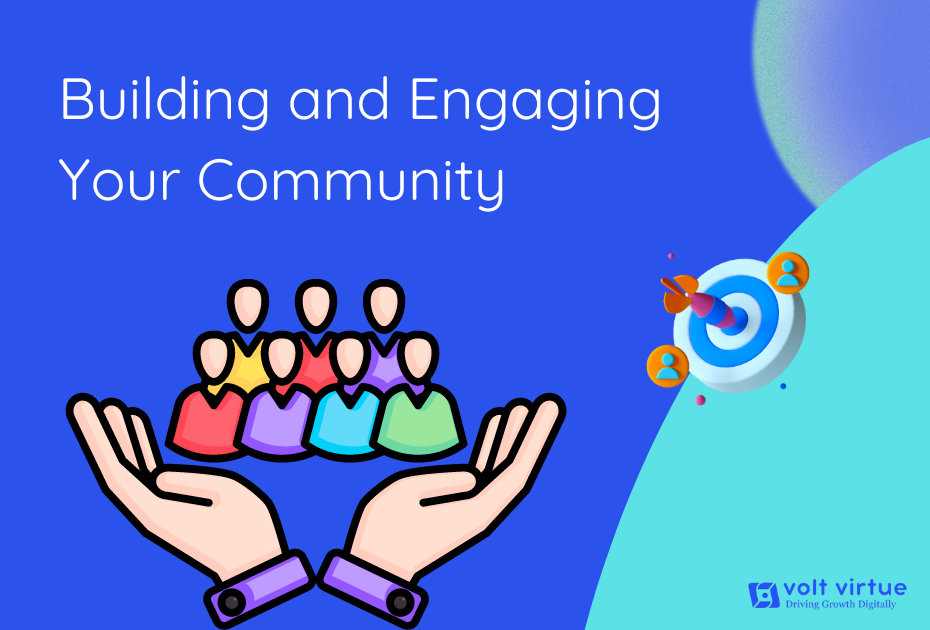
In the vast social media landscape, brands face the challenge of resonating with their audience. To effectively grow your followers and foster a vibrant community, consider these strategies and tactics:
Strategies to Grow Your Followers
Utilize Hashtags: Hashtags can broaden the visibility of your content, especially on platforms like Instagram and Twitter. Research and utilize popular, brand-relevant, and trending hashtags to attract new followers.
Create Shareable Content: Sharing content that makes people feel something is more likely if it also adds value or is entertaining. Aim to create content that resonates with your audience and motivates them to share it.
Consistent Brand Storytelling: Use social media to narrate your brand’s story, showcasing its values, mission, and the benefits of your products or services. Consistent storytelling strengthens your brand identity.
Leverage User-Generated Content: Invite people that are interested in your brand to create content. User-generated content fosters a sense of community and can attract more followers who engage with your brand.
Engagement Tactics
Prompt and Personalized Responses: React quickly and individually to mentions, DMs, and comments. This demonstrates that you value your audience’s input and helps build stronger connections.
Create Interactive Content: Use polls, quizzes, and questions to invite direct interaction with your audience. Interactive material increases viewership and provides insightful information about the tastes of your audience.
Host Live Sessions: Live videos on platforms like Instagram, Facebook, and YouTube enable real-time interaction with your audience. To increase interaction, host Q&A sessions, product launches, or behind-the-scenes footage.
Regular Engagement Initiatives: Engage your audience consistently with themed posts, weekly challenges, or hashtag campaigns. Consistent engagement helps maintain an active and lively community.
Creating a Sense of Community and Belonging Transforming your social media followers from a mere audience into a loyal community involves fostering a sense of belonging. Here’s how to cultivate this:
Promote Values and Causes: To increase interaction, host Q&A sessions, product launches, or behind-the-scenes footage. By championing shared beliefs, you create a sense of purpose that unites your followers and strengthens their connection to your brand.
Encourage Dialogue and Sharing: Make areas on your social network accounts for fans to post their thoughts, experiences, and tales. This encourages active participation and deepens the sense of community.
Offer Exclusive Benefits: Offer your social media followers exclusive content, special offers, or early access to products. This sense of exclusivity enhances loyalty and fosters brand advocacy.
Community Support and Recognition: Acknowledge and support your followers by celebrating their achievements, sharing their content, or offering assistance when needed. Recognizing their contributions fosters stronger relationships and loyalty.
Create Brand Ambassadors: Identify and empower active community members as brand ambassadors. Their genuine enthusiasm and content can inspire others and help amplify your brand’s message.
How to Analyze Social Media Marketing Impact and Results
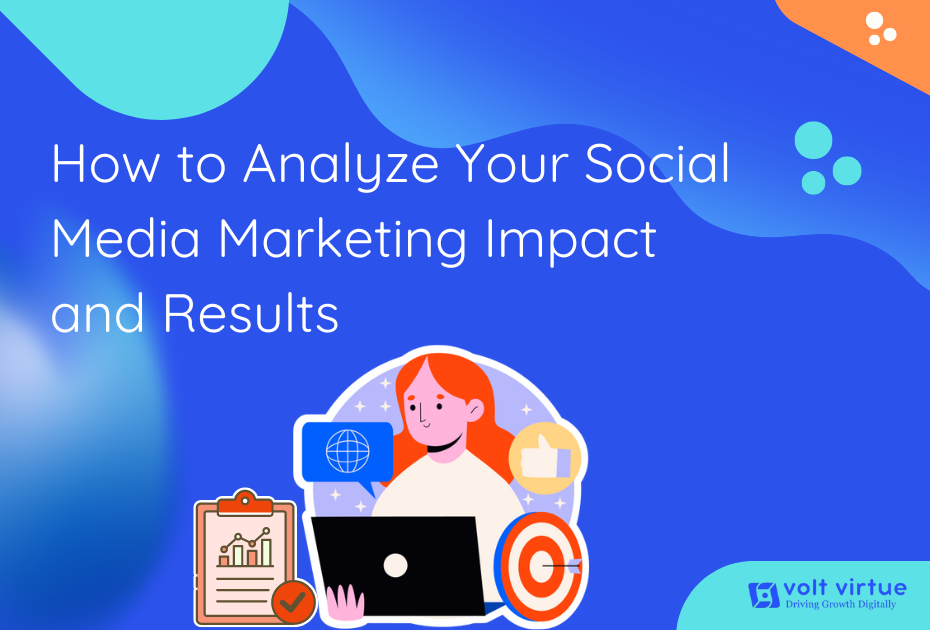
To ensure your social media marketing efforts are effectively meeting your goals, it’s crucial to track and review your performance metrics across all platforms. Here’s how you can analyze your impact and results:
Social Media Metrics
Social media metrics provide data on how well your posts are performing and their impact on your audience. Key metrics to track include:
- Engagement: Measures interactions such as clicks, comments, likes, and replies on your posts. Platform-specific interactions, like “Saved” posts on Instagram or “Pinned” posts on Pinterest, also fall under this category.
- Reach: The total count of distinct users who have visited any of the content associated with your page or profile.
- Followers: The number of people who have clicked your “Follow” button, ensuring they see your content regularly in their feeds.
- Impressions: The total number of times your post is displayed, regardless of whether it was interacted with. Impressions typically result from users scrolling through their feeds.
- Video Views: The number of times videos posted on platforms like Facebook, YouTube, or Instagram have been watched.
- Profile Visits: The count of how many times users have visited your profile.
- Mentions and Tags: Instances where users mention your brand or tag your profile in their posts.
- Reposts: The frequency at which your content is shared by users on their profiles.
- Shares: The number of times content from your profile is shared by users with their own network or within their communities.
By consistently monitoring these metrics, you can gain valuable insights into what’s working, identify areas for improvement, and adjust your strategies to better achieve your social media marketing objectives.
Analytics and Measurement
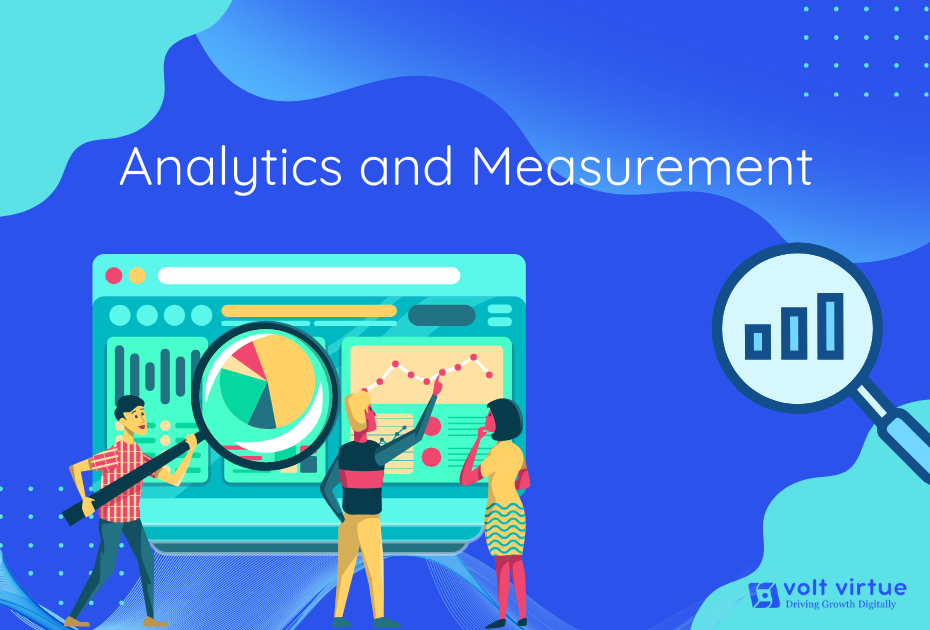
Navigating social media marketing without data is like sailing without a compass. Analytics are crucial—they form the bedrock of effective strategies and provide the insights needed to steer your marketing efforts toward success.
By diving into data, brands can gain a deeper understanding of their audience, refine their content, and boost their ROI. This transforms a generic approach into a finely tuned strategy tailored to specific goals.
Key Performance Indicators (KPIs) to Track
KPIs are the lights that lead the way to successful marketing. They help quantify progress, evaluate effectiveness, and direct your social media strategies toward achieving your goals.
Reach KPIs
Reach KPIs gauge the extent of your content’s visibility and how far your message spreads across social media. They provide valuable insights into your audience size and your content’s potential to attract new followers.
- Impressions: The total number of times your content is displayed, regardless of engagement or clicks. This metric shows how frequently your content appears, which is vital for building brand awareness.
- Follower Growth Rate: Measures the pace at which your follower count is increasing, providing insight into how quickly you are gaining new audience members over a given period.
- Reach: Your post is seen by the number of unique users. In contrast to impressions, reach gives you a more accurate idea of the size of your audience by showing you the total number of distinct people who have viewed your content.
Social Media Engagement KPIs
Engagement KPIs evaluate the interactions between your content and audience. High engagement rates indicate that your audience is effectively connecting with your content.
- Likes, Comments, and Shares: These are the most direct indicators of engagement, showing how users interact with your content. High numbers suggest that your content is resonating and prompting interaction.
- Engagement Rate: Calculated as a percentage of total engagements divided by total impressions or reach, then multiplied by 100. This metric provides insight into how engaging your content is relative to its visibility.
- Mentions: Tracks the frequency with which your brand is mentioned across social platforms. More mentions indicate higher visibility and engagement with your brand.
Social Media Advertising
If you’re looking to amplify your social media marketing efforts, investing in social media ads is a smart move. A well-executed ad campaign can help you reach a broader audience beyond your current followers, expanding your reach and growing your following.
Social media ads offer precise targeting capabilities. You can target your audience according to their demographics, hobbies, lifestyles, and more. Platforms like Meta provide powerful Ads Manager tools that enable cross-posting across all their platforms, even if you don’t have a profile on each one.
Social media advertising typically has a lower average cost-per-click (CPC) compared to Google Ads. For instance, the average CPC for Facebook ads across all industries is $0.97, whereas the average CPC for Google Ads is $3.58.
When managing multiple campaigns, consider using social media ads tools to streamline bulk changes, automate processes, and optimize your ad performance.
Conclusion
This social media marketing guide has emphasized the vital role that social media plays in our digital lives. With people spending extensive time on social platforms to stay updated with trends and news, harnessing social media effectively is essential for any business.
Regardless of your business’s size, developing a robust social media strategy is key to growth. Make use of the resources and technologies at your disposal to produce and distribute engaging content that tells the story of your business. Set clear goals, regularly refine your strategy, and continuously explore new ways to engage with your audience. While building a strong social media presence takes time, the investment is crucial for your business’s success.
Frequently Asked Questions About the SMM
1. Why is social media important for businesses?
Answer: Social media can be a powerful driver of traffic for your business and deliver substantial ROI, whether you’re leveraging organic reach, paid advertising, or a combination of both.
2. What does a social media manager do?
Answer: A social media manager handles the strategy and execution of your brand’s social media presence. They are responsible for crafting and posting content, managing interactions, and analyzing performance. As the brand’s online representative, they provide strategic insights to enhance your online presence.
3. How do marketers use social media?
Answer: Marketers leverage social media platforms to connect with and expand their audience by enhancing brand awareness and driving sales. They use various social media tools and strategies to attract customers and followers to their websites or stores, effectively boosting their online presence and engagement.
4. Why is social media good for marketing?
Answer: Social media offers a cost-effective and versatile approach to marketing in today’s digital era. Making use of social media platforms can significantly boost traffic, strengthen brand loyalty, and improve customer satisfaction. It also offers an opportunity to establish a competitive edge and draw in a new generation of clients.
Looking For Social Media Marketing Services: Contact Us

